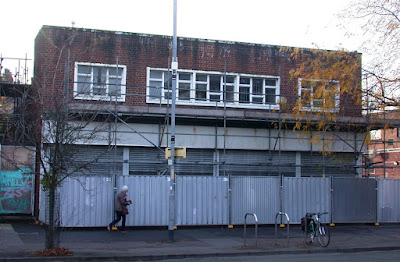The inscription on this gravestone situated in the old St. Clement’s Churchyard, Chorlton-cum-Hardy is now very weather-worn and is becoming increasingly difficult to de-cypher.
Indeed, I have been unable to make out the lowest portion and I issue a challenge to anyone to come up with the wording
.It marks the final resting place of two young daughters of Robert Lodge and his wife Mary (née Watkins). 7-years-old Grace Helen who was interred there on the 3rd January, 1856 having died the previous 30th December at her home on Dudley Road, Whalley Range and Winifred Beavan who was only 14 days old when she was buried on the 7th January, 1860. Grace Helen was baptised on the 15th January, 1849 in the parish church of Ashton-on-Mersey, Cheshire.
In the baptismal register her father’s status is recorded as a “Gentleman” of Sale (Cheshire). The census of 1851 records the family at School Lane, Sale, with the father’s occupation being given as “merchant (oil)”. (1) By this time a second daughter, Elizabeth, had been born in, 1850. Winifred Beavan was christened at St. Mary’s Church, Hulme on Christmas Eve, 1859, a sister, Isabella, had been christened in the same church on the 31st May of the year before.
.jpg) |
| St. Mary's Church, Hulme. |
Robert Lodge, who was born in Halifax, West Yorkshire, in 1817, married Mary, the daughter of William Watkins (2) of Ardwick, Manchester, in Manchester’s Collegiate Church (now Manchester Cathedral) on the 5th August, 1847.
Following the tragic loss of his two daughters Robert and his remaining family relocated to North Meols on the West Lancashire coast. His still young, at just 38-years-old, wife died there soon after their arrival. Her body was returned to Manchester, and interred, on the 22nd November, 1860, in the same grave in Chorlton-cum-Hardy as her two children. The 1861 census shows that as well as Elizabeth and Isabella mentioned above Robert was left with three other children, all born in Whalley Range, Caroline Ann, 9, Alice, 7, and John William, 5. Completing the household at 166, Lord Street, North Meols were Robert’s unmarried sister, Alice and three servants.
In 1871, the Lodges were still in Lancashire at 11, Queens Road, Southport, however by then a further tragedy had hit the family as Caroline Ann, at only 14 years of age, had passed away in the June quarter of 1866. The household consisted of Robert Lodge, three of his children, Elizabeth, John William, and Isabella, and four servants. His daughter, Alice, was away from home at a boarding school for young ladies.
.jpg) |
| Upper Bishopdale |
In retirement, Robert returned to his birth county becoming a “country gentleman” in Bishopdale, Yorkshire (North Riding). His house, “The Rookery” which he inherited in July, 1873 from his uncle Ralph, remained the family home for more than 30 years. (3) He died there on the 12th September, 1888 leaving an estate of £12, 215-4s-7d. (£1.1 million at today’s value).
Finally, the verse: -
“He shall gather the lambs with his arm and carry them in his bosom”
is from King James’s Bible, Old Testament -Isaiah 40:11
Pictures: - Lodge family grave, Chorlton-cum-Hardy, from the collection of Tony Goulding.
St. Mary's Church, Hulme by H. Milligan m70933
Courtesy of Manchester Libraries, Archives and Information, Manchester City Council http://manchester.gov.uk/index.php?session=pass
Upper Bishopdale by Chris Heaton, CC BY-SA 2.0,
https://commons.wikimedia.org/w/index.php?curid=3099436
Alderman William Benjamin Watkins by George Patten (1801-1865) – (photo by Manchester Town Hall) Creative Commons Attribution-NonCommercial-NoDerivatives licence (CC BY-NC-ND). From Art U K website https://artuk.org
Notes: -
1) Subsequent records describe Robert Lodge as a “Drysalter”
2) Alderman William Benjamin Watkins J.P.;
Alderman William Benjamin Watkins
 |
| Alderman William Benjamin Watkins |
Served as the 5th Mayor of Manchester 1845-1846. He was born in 1789 in Hereford, Herefordshire and married (Mary Lodge’s mother) Caroline Beavan in Herefordshire before coming to Manchester and setting up in business as a drysalter. Alderman Watkins resigned from office on the grounds of ill-health in August, 1862 and died during the June quarter of 1864. His widow survived him for over three years dying at their home Legh House, Legh Place, Ardwick, Lancashire on the 30th June, 1867.
3) Robert’s son, John William, died at “The Rookery” on the 23rd August, 1917. He was “called to the Bar” of the Inner Temple on the 26th January, 1883. Three days later, the 29th, January, 1883, after having previously graduated with a B.A. from Gonville and Caius College, Cambridge, the same college conferred an M.A. degree on him. While still at Cambridge he joined the British Army, being gazetted into the 3rd (volunteer) battalion of The Princess of Wales Own Yorkshire Regiment on the24th June, 1874. He remained an officer with this regiment for almost 40 years, including service in South Africa during the 2nd Boer War, before retiring, in 1912, as the Colonel in command of its 3rd Battalion. At the outbreak of the First World War, he volunteered for war service and when he died was commanding the 2nd (Garrison) Battalion of The Yorkshire Regiment. He was a county magistrate and served on both the North Riding and District councils and an enthusiastic follower of “country sports”.
The estate passed to his sister, Elizabeth, the widow of Matthew Liddon, and following her subsequent death, on the 20th July, 1920, to her son, Major Matthew Robert Liddon. Major Liddon sold up the property the following year and its long association with the Lodge family came to an end.
Acknowledgements: - Find my Past’s Newspaper Archive and Thoralby through time https://www.thoralbythroughtime.net which was a good source of data on the Lodge family and the “Rookery”.


.jpg)















.jpg)
.jpg)
.jpg)
.jpg)






























